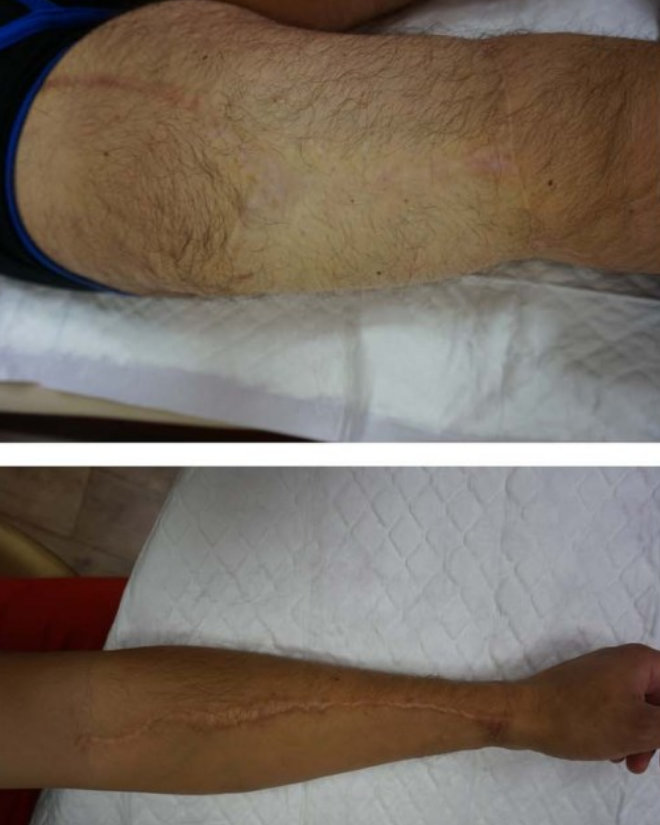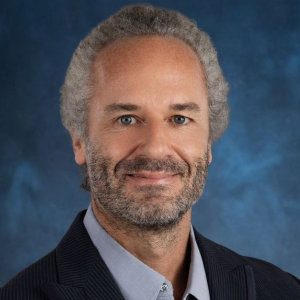Single Scar ALT Phalloplasty with Tissue Expansion
 Single Scar Phalloplasty (SSP) using tissue expansion is an emerging technique in gender-affirming surgery designed to minimize visible donor site scarring. This innovative method involves expanding a section of thigh skin prior to surgery so that the tissue can be harvested and the donor site closed with a single linear scar. Unlike traditional ALT phalloplasty that requires skin grafting and results in wide areas of scarring on the donor site, SSP allows for a more discreet aesthetic outcome. Currently, Dr. Dev Gurjala at Align Surgical in San Francisco is the only surgeon in the United States offering this technique.
Single Scar Phalloplasty (SSP) using tissue expansion is an emerging technique in gender-affirming surgery designed to minimize visible donor site scarring. This innovative method involves expanding a section of thigh skin prior to surgery so that the tissue can be harvested and the donor site closed with a single linear scar. Unlike traditional ALT phalloplasty that requires skin grafting and results in wide areas of scarring on the donor site, SSP allows for a more discreet aesthetic outcome. Currently, Dr. Dev Gurjala at Align Surgical in San Francisco is the only surgeon in the United States offering this technique.
How It Works
SSP begins with the placement of one or more tissue expanders beneath the skin of the thigh, outside the area designated for the donor site flap. Over several months, these expanders are gradually inflated to stretch the surrounding skin. Once adequate expansion is achieved—typically at least four months after full inflation—the patient undergoes phalloplasty. The expanded skin is used to close the donor site primarily, eliminating the need for a skin graft and reducing the overall scarring to a single line.
This technique is particularly useful in cases where skin thickness and elasticity allow for a well-vascularized flap and primary closure. Urethral lengthening is optional.
Preoperative Tissue Expansion in Phalloplasty
While SSP is the most recognized example of tissue expansion in U.S. phalloplasty today, tissue expansion has been studied more broadly in other countries. Two studies represent the range of outcomes possible with this method.

Postoperative donor-site scar examples. 1. Preexpanded ALT phalloplasty; 2. Preexpanded ALT/RFFF phalloplasty. Source: Preexpansion in Phalloplasty Patients: Is It Effective? © 2019 Wolters Kluwer Health, Inc.
A 2019 retrospective study by gender surgeons in the Netherlands assessed preoperative tissue expansion in 33 transmasculine phalloplasty patients (both ALT and radial forearm flaps). Among the 17 patients who received expanders, only 31% achieved primary closure of the donor site. Complication rates were high, with 52.9% of expanders failing due to issues like infection, extrusion, or leakage, and 21% of patients required reoperations. The study also found no significant difference in scar quality or patient satisfaction between the expanded and non-expanded groups, leading the authors to conclude that the risks outweigh the benefits of routine expansion.
In contrast, a 2017 case series and technical report by phalloplasty surgeons in Belgium demonstrated more favorable outcomes. They reported on nine transmasculine patients who underwent ALT phalloplasty using pre-expanded flaps. Six of seven patients achieved successful primary closure, and overall cosmetic outcomes were significantly improved. While there were still a few complications (e.g., port leaks, one infection, and one flap necrosis), the authors concluded that preexpansion is a valuable option for patients who are highly motivated to reduce scarring, as it can significantly improve the appearance of the donor site by enabling primary closure and avoiding the patchy, uneven look associated with skin grafts.
Together, these studies highlight that the success of tissue expansion in phalloplasty is highly dependent on multiple factors, including surgeon experience, surgical planning (such as perforator mapping via CT scan), donor site selection, and the patient's ability to commit to the process. For those considering this technique, the key takeaway is that while tissue expansion can significantly improve donor site appearance when performed meticulously, it also carries risks and requires careful coordination between an experienced surgical team and a well-prepared, motivated patient.
Expected Results
Beyond construction of the neophallus, the expected result with SSP is improved aesthetic appearance of the donor site. The major aesthetic advantage is a linear scar rather than a broad, skin-grafted area. Some people may also benefit from reduced donor-site depression and improved skin texture.
However, results vary depending on the individual’s anatomy, adherence to surgeon instructions, and healing response. Long-term outcomes are still being studied.
Risks and Complications
While SSP offers substantial aesthetic advantages, it’s not without risk. Both the Dutch and Belgian studies identified complications associated with tissue expansion including:
- Infection at the expander site
- Expander rupture or deflation
- Skin breakdown or necrosis
- Need for reoperation due to expander-related issues
Complementary Procedures
SSP can be performed with or without the following additional procedures:
- Urethral Lengthening: For those seeking to urinate while standing.
- Glansplasty: To sculpt the appearance of a glans penis.
- Scrotoplasty & Testicular Implants: For those opting for full genital reconstruction.
- Fat Grafting: To improve contour at the donor site or neophallus.
- Erectile Device Placement: Performed in a later stage for sexual / penetrative function.
Pros and Cons
Pros:
- Significantly reduced donor site scarring
- Avoidance of skin grafts
- Improved donor site contour
Cons:
- Requires months of expansion
- High complication rate for expanders
- Longer surgical timeline
- Limited availability; only offered by Dr. Gurjala to select patients
- Dr. Gurjala's patients must live in the Bay Area or stay close by for several months
Who Is This Procedure Right For?
- Individuals with low to moderate body fat and good skin elasticity
- Those willing to commit to a longer, staged process
- In overall good health for surgery and recovery
Patients must undergo a detailed consultation and evaluation to determine eligibility.
Recovery
After Tissue Expander Placement:
- Return to light activity in 1–2 weeks
- Weekly or biweekly expansion visits
- Close monitoring for infection or complications
After Phalloplasty Surgery:
- Usual recovery from ALT phalloplasty
- Reduced discomfort at the donor site due to primary closure and no skin graft site to heal
- Long-term follow-up to assess healing and functionality
Tissue Expansion Following Primary ALT Phalloplasty
 Tissue expansion can also be used to revise the donor site after a previous ALT phalloplasty. In one case described by Dr. Curtis Crane, a 31-year-old FTM patient of who had undergone right ALT phalloplasty disliked the appearance of his skin-grafted donor site and felt self-conscious wearing shorts. Approximately three years after his initial surgery, he elected to undergo tissue expansion to reduce the visible scarring.
Tissue expansion can also be used to revise the donor site after a previous ALT phalloplasty. In one case described by Dr. Curtis Crane, a 31-year-old FTM patient of who had undergone right ALT phalloplasty disliked the appearance of his skin-grafted donor site and felt self-conscious wearing shorts. Approximately three years after his initial surgery, he elected to undergo tissue expansion to reduce the visible scarring.
His insurance covered a single 800 cc expander, which was placed to the side of the skin graft scar. The expander was initially filled to 250 cc and gradually expanded to 850 cc over a nine-week period. Approximately 50% of the skin graft was removed and replaced with the newly expanded skin. Dr. Crane noted that future expansion procedures to improve the cosmetic outcome even more would be feasible.
Surgeons Offering Single Scar Phalloplasty
Dr. Dev Gurjala at Align Surgical in San Francisco is currently the only known surgeon in the United States offering Single Scar Phalloplasty using tissue expansion. However, surgeons in the Netherlands and Belgium have also utilized this method.
Single Scar ALT Phalloplasty using tissue expansion is an innovative, aesthetic-focused phalloplasty technique that offers an alternative to traditional ALT donor site closure. While it comes with added complexity and a longer surgical timeline, the potential for minimized scarring is a compelling benefit. As with any surgical innovation, careful patient selection, informed consent, and collaboration with an experienced surgical team are essential.
References
- Givant, M., Apostle, A., Korenblit, M., Hu, A. C., & Gurjala, D. (2025, May). Single-scar anterolateral thigh phalloplasty with tissue expander placement: A case report [Poster presentation]. California Society of Plastic Surgeons Meeting, California, USA.
- Elfering, L., van der Sluis, W. B., Bouman, M. B., Buncamper, M. E., van de Grift, T. C., Lissenberg-Witte, B. I., Middelkoop, E., & Mullender, M. G. (2019). Preexpansion in Phalloplasty Patients: Is It Effective? Annals of Plastic Surgery, 83(6), 687–692. https://doi.org/10.1097/SAP.0000000000001968. FULL TEXT.
- Monstrey, S., D'Arpa, S., Colebunders, B., Lumen, N., & Hoebeke, P. (2017). Anterolateral thigh flap phalloplasty. In C. J. Salgado, G. Monstrey, & M. L. Djordjevic (Eds.), Gender affirmation: Medical and surgical perspectives (pp. 135–154). Thieme Medical Publishers.
- D'Arpa, S., Colebunders, B., Stillaert, F., & Monstrey, S. (2017). Pre-expanded Anterolateral Thigh Perforator Flap for Phalloplasty. Clinics in Plastic Surgery, 44(1), 129–141. https://doi.org/10.1016/j.cps.2016.08.004. FULL TEXT.
- Aggarwal A, Singh H, Mahendru S, Brajesh V, Singh S, Ghag N, Khazanchi RK. Minimising the donor area morbidity of radial forearm phalloplasty using prefabricated thigh flap: A new technique. Indian J Plast Surg. 2017 Jan-Apr;50(1):91-95. doi: 10.4103/ijps.IJPS_158_16. PMID: 28615818; PMCID: PMC5469244.
- Hallock, G. G. (2013). Tissue expansion techniques to minimize morbidity of the anterolateral thigh perforator flap donor site. Journal of Reconstructive Microsurgery, 29(9), 565–570. https://doi.org/10.1055/s-0033-1348035
- Align Surgical. Single Scar Phalloplasty. Retrieved from https://alignsurgical.com/phalloplasty/
Last updated: 06/14/25